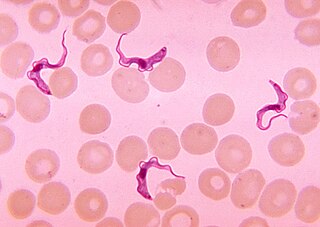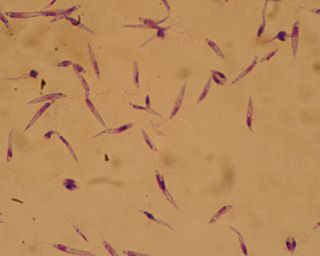| Besnoitia | |
|---|---|
| Scientific classification | |
| Kingdom: | Chromista |
| Superphylum: | Alveolata |
| Phylum: | Apicomplexa |
| Class: | Conoidasida |
| Order: | Eucoccidiorida |
| Family: | Sarcocystidae |
| Genus: | Besnoitia |
| Species [1] | |
Besnoitia is a genus of apicomplexan parasites.
| Besnoitia | |
|---|---|
| Scientific classification | |
| Kingdom: | Chromista |
| Superphylum: | Alveolata |
| Phylum: | Apicomplexa |
| Class: | Conoidasida |
| Order: | Eucoccidiorida |
| Family: | Sarcocystidae |
| Genus: | Besnoitia |
| Species [1] | |
Besnoitia is a genus of apicomplexan parasites.
The life cycle of many of the species in this genus are not known. The life cycle may be complex with various intermediate hosts and vectors including Stomoxys and Tabanidae .
Infection with these parasites causes pedunculated lesions in the skin, nasal cavity and larynx of domestic animals. The lesions consist of exophytic nodules protruding from mucosal surfaces.

Plasmodium is a genus of unicellular eukaryotes that are obligate parasites of vertebrates and insects. The life cycles of Plasmodium species involve development in a blood-feeding insect host which then injects parasites into a vertebrate host during a blood meal. Parasites grow within a vertebrate body tissue before entering the bloodstream to infect red blood cells. The ensuing destruction of host red blood cells can result in malaria. During this infection, some parasites are picked up by a blood-feeding insect, continuing the life cycle.
Veterinary parasitology is the study of animal parasites, especially relationships between parasites and animal hosts. Parasites of domestic animals,, as well as wildlife animals are considered. Veterinary parasitologists study the genesis and development of parasitoses in animal hosts, as well as the taxonomy and systematics of parasites, including the morphology, life cycles, and living needs of parasites in the environment and in animal hosts. Using a variety of research methods, they diagnose, treat, and prevent animal parasitoses. Data obtained from parasitological research in animals helps in veterinary practice and improves animal breeding. The major goal of veterinary parasitology is to protect animals and improve their health, but because a number of animal parasites are transmitted to humans, veterinary parasitology is also important for public health.

Trypanosoma is a genus of kinetoplastids, a monophyletic group of unicellular parasitic flagellate protozoa. Trypanosoma is part of the phylum Sarcomastigophora. The name is derived from the Greek trypano- (borer) and soma (body) because of their corkscrew-like motion. Most trypanosomes are heteroxenous and most are transmitted via a vector. The majority of species are transmitted by blood-feeding invertebrates, but there are different mechanisms among the varying species. Some, such as Trypanosoma equiperdum, are spread by direct contact. In an invertebrate host they are generally found in the intestine, but normally occupy the bloodstream or an intracellular environment in the vertebrate host.

Tunga penetrans is a species of flea also known as the jigger, jigger flea, chigoe, chigo, chigoe flea, chigo flea, nigua, sand flea, or burrowing flea. It is a parasitic insect found in most tropical and sub-tropical climates. In its parasitic phase it has significant impact on its hosts, which include humans and certain other mammalian species. A parasitical infestation of T. penetrans is called tungiasis. Jiggers are often confused with chiggers, a type of mite. Jiggers are native to Central and South America, and have been introduced by colonialists to sub-Saharan Africa.
Coccidiosis is a parasitic disease of the intestinal tract of animals caused by coccidian protozoa. The disease spreads from one animal to another by contact with infected feces or ingestion of infected tissue. Diarrhea, which may become bloody in severe cases, is the primary symptom. Most animals infected with coccidia are asymptomatic, but young or immunocompromised animals may suffer severe symptoms and death.
Besnoitia bennetti is a parasite that can cause besnoitiosis infections in donkeys. The range of this organism ranges from Africa to the United States. B. bennettii shares similar characteristics with Toxoplasma, Neospora, and Sarcocystis genera. Lab work onB. bennetti is conducted at biosafety level 1.
Besnoitia besnoiti is an apicomplexan protozoan parasite, closely related to Toxoplasma gondii and Neospora caninum,. It is part of a larger genus Besnoiti affecting multiple animal species, but Besnoita besnoiti, can affect livestock. and more specifically cattle as intermediate host, although some specific antibodies have been found in roe deer and red deer.
Besnoitia tarandi is a species of single-celled parasites that afflicts reindeer.
Spirometra erinaceieuropaei is a parasitic tapeworm that infects domestic animals and humans. The medical term for this infection in humans and other animals is sparganosis. Morphologically, these worms are similar to other worms in the genus Spirometra. They have a long body consisting of three sections: the scolex, the neck, and the strobilia. They have a complex life cycle that consists of three hosts, and can live in varying environments and bodily tissues. Humans can contract this parasite in three main ways. Historically, humans are considered a paratenic host; however, the first case of an adult S. erinaceieuropaei infection in humans was reported in 2017. Spirometra tapeworms exist worldwide and infection is common in animals, but S. erinaceieuropaei infections are rare in humans. Treatment for infection typically includes surgical removal and anti-worm medication.

Sarcocystis is a genus of protozoan parasites, with many species infecting mammals, reptiles and birds. Its name is dervived from Greek sarx = flesh and kystis = bladder.

The Sarcocystidae are a family of Apicomplexa associated with a variety of diseases in humans and other animals.

Leucocytozoon is a genus of parasitic alveolates belonging to the phylum Apicomplexa.
Megaloschizonts are large schizonts that produce extremely high numbers of merozoites. They are found in various species of the Phylum Apicomplexa. The Apicomplexa phylum contains several parasitic protozoans. They have a very complex life cycle that includes several stages. Megaloschizonts and the smaller schizonts are the part of the life cycle that takes place inside the infected host organism and operates as an asexually reproductive cell. Megaloschizonts appear as grey-white nodules found in the smooth muscle of major organs, such as the heart, liver, lung or spleen.

Leishmania major is a species of parasite found in the genus Leishmania, and is associated with the disease zoonotic cutaneous leishmaniasis. L. major is an intracellular pathogen which infects the macrophages and dendritic cells of the immune system. Though Leishmania species are found on every continent aside from Antarctica, Leishmania major is found only in the Eastern Hemisphere, specifically in Northern Africa, the Middle East, Northwestern China, and Northwestern India.
Muelleries capillaris, also known as the hair or goat lungworm, is one of the most economically important nematodes of small ruminants. Although normally non-pathogenic in sheep, the parasite causes a disease condition called muelleriosis in goats. Sheep and goats commonly become infected after accidentally ingesting M. capillaris infected snails or slugs, and the parasite produces eggs in the lungs of its host, causing life-threatening bronchopneumonia in serious cases.
Elaeophora elaphi is a nematode parasite found in the blood vessels of the liver in Red Deer in certain parts of Spain. The adult male measures 77 mm long and 549 µm wide, adult females are 91–109 mm long and 793-1049 µm wide, and microfilariae are 225 µm long. Though adult E. elaphi induce lesions in the blood vessels, and appear to activate the local immune response, they seldom cause overt clinical symptoms in their hosts.
Elaeophora sagitta is a parasitic nematode found in the heart, coronary arteries and pulmonary arteries of several ruminant species and African buffaloes in Africa. Infestation usually occurs without significant health effects in the Greater kudu, but may affect cardiac function in some other host species.

Adeleorina is a suborder of parasites in the phylum Apicomplexa.
Nephroisospora is a genus of parasites that infects bats
Pseudoklossia is a genus in the phylum Apicomplexa. Species in this genus infect marine molluscs, although one species infects in an ascidian worm. The life cycle is heteroxenous.